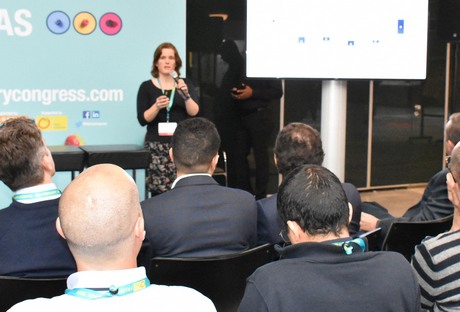The International finance institution, Rabobank says the seasonal nature of strawberry production and the volatility in prices can make it risky for growers wanting to invest in the industry, if they do not mitigate.
Cindy van Rijswick, told the Global Berry Congress Expo in the Rotterdam, recent research from the company found that financing a high capital, intense system like a lighted greenhouses is fairly risky because of the price fluctuations.
"First we looked at the main risks that growers are confronted with," she said. "For the risk model that we used on the data, it seems that price is the main risk," she said. "About 80 per cent of the grower margin risk is caused by price, so that is by far the most important one. The financial risk, such as interest rates, is quite small. The cost risks, in terms of labour costs, is also fairly small. Even production risks, such as lower yields are fairly small, compared to the price risk."

Ms van Rijswick adds that it is necessary to control these price risks: "We also modelled a scenario where with further price decreases to see what could happen to the different glasshouses we analysed," she said. "What we saw was the lighted glasses is most vulnerable to price shocks. That is not a surprise because they operate and produce in a few months with very high price volatility. So, we think that growers who want to invest in this, should mitigate their risk by spreading the marketing windows over the year, so maybe produce different systems, for different countries, or have agreements with their off-takers to reduce the price risk."
It is also affected by the months that producers are producing strawberries, as it still a seasonal product, according to Rabobank, even though it has become available year-round.
"I looked at Germany and about 55 per cent of strawberries are bought in two months of the year," Ms van Rijswick said. "It has shifted a little bit, to the spring season instead of the summer season. We see seasonality exist in all countries even the United States, United Kingdom and the Netherlands. It is still rather a seasonal product, especially when compared to other berries. In Holland, about 35 per cent of strawberries are bought in two months, so that is also still quite a lot."
The strawberry market is so small in winter time, Ms van Rijswick says, that the changes in supply and demand affect prices quite severely.
"We looked at prices over a long period, but took out the extremes as sometimes there are extreme prices," she said. "So, you see in February and March, prices on the Dutch market, and it similar for Belgium and Northern European countries, there's a high variation of between €3 and €10 per kilogram. So, it makes it attractive for growers during these months, but if the price is only €3 per kilo, it is not profitable at all."
She says that while it is attractive to get a premium in certain months of the year, it is unknown if this trend will remain in the future. There are also questions surrounding whether Spanish competition or supply in Northern Europe will increase too much, meaning price of the premium will drop, adding to the investment risk.
"Recently there has been a research project from Belgium government on profitability of different production systems," Ms van Rijswick said. "We can see that the family farm incomes were mentioned as being positive for all production systems, but it is different for heated clean glasshouses with tabletop production. The variation was also higher in glasshouse production. This is what we know from our own research. We looked at margins in different glasshouse systems; so small, medium-size, large and glasshouses and also glasshouses with lighting. We see that there is a big difference on income and margin levels - between growers and between years. There is a lot of volatility."
She concluded by saying: "I think further sophistication in strawberries is inevitable, because of sustainability requirements, soil health, consistency, labour use etc. But the high investments come with a risk, and that risk needs to be mitigated by the growers otherwise, the risk can become too high for a bank to finance these projects."
